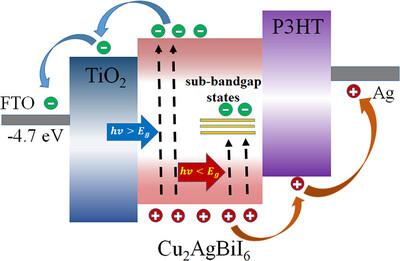Cu2AgBiI6钙钛矿亚带隙光子捕获实现自供电近红外光探测
IF 10
1区 物理与天体物理
Q1 OPTICS
引用次数: 0
摘要
近红外(NIR)光探测在许多领域都有重要的应用。为了提高卤化物钙钛矿的近红外响应,两种主要方法是通过掺杂/合金化来减小带隙或产生亚带隙状态。在本研究中,通过上转换发光分析证实了无铅钙钛矿Cu2AgBiI6 (CABI)薄膜中存在亚带隙态。得益于亚带隙状态的吸收,基于CABI薄膜的自供电光电探测器在光学间隙以下获得了强的近红外光响应。在此基础上,将具有局部表面等离子体共振(LSPR)效应的纳米复合材料nacsw3 /聚乙烯吡咯烷酮(PVP)策略性地整合到器件中,以设计CABI膜和空穴传输层之间的界面,从而实现光捕获和载流子传输动力学的同时优化。优化后的光电探测器在808 nm和980 nm光照射下,在0 V偏置下的比光探测率分别为4.08 ×1 011和1.13 × 1011 Jones。这些结果证明了无铅钙钛矿作为光敏材料的巨大潜力,以及设计新型近红外光电探测器的可能性。本文章由计算机程序翻译,如有差异,请以英文原文为准。

Sub‐Bandgap Photon Harvesting in Cu2AgBiI6 Perovskite Enabling Self‐Powered Near‐Infrared Photodetection
Near‐infrared (NIR) photodetection has important applications in many fields. To improve NIR response in halide perovskites, two main approaches are reducing the bandgap or creating sub‐bandgap states through doping/alloying. In this study, the existence of sub‐bandgap states in lead‐free perovskite Cu2 AgBiI6 (CABI) thin films is confirmed through upconversion luminescence analysis. Benefiting from the sub‐bandgap states absorption, self‐powered photodetectors based on CABI films achieve strong NIR photoresponses significantly below the optical gap. Building upon this foundation, nanocomposite NaCsWO3 /polyvinylpyrrolidone (PVP) with localized surface plasmon resonance (LSPR) effect is strategically incorporated into the device to engineer the interface between the CABI film and the hole‐transport layer, thereby achieving simultaneous optimization of light harvesting and carrier transport dynamics. The optimized photodetector can obtain specific photodetectivity of 4.08 ×1 011 and 1.13 × 1011 Jones under 808 and 980 nm light illumination at 0 V bias, respectively. These results demonstrate the enormous potential of lead‐free perovskite as light‐sensing materials and the possibility of designing a new class of NIR photodetectors.
求助全文
通过发布文献求助,成功后即可免费获取论文全文。
去求助
来源期刊
CiteScore
14.20
自引率
5.50%
发文量
314
审稿时长
2 months
期刊介绍:
Laser & Photonics Reviews is a reputable journal that publishes high-quality Reviews, original Research Articles, and Perspectives in the field of photonics and optics. It covers both theoretical and experimental aspects, including recent groundbreaking research, specific advancements, and innovative applications.
As evidence of its impact and recognition, Laser & Photonics Reviews boasts a remarkable 2022 Impact Factor of 11.0, according to the Journal Citation Reports from Clarivate Analytics (2023). Moreover, it holds impressive rankings in the InCites Journal Citation Reports: in 2021, it was ranked 6th out of 101 in the field of Optics, 15th out of 161 in Applied Physics, and 12th out of 69 in Condensed Matter Physics.
The journal uses the ISSN numbers 1863-8880 for print and 1863-8899 for online publications.

 求助内容:
求助内容: 应助结果提醒方式:
应助结果提醒方式:


